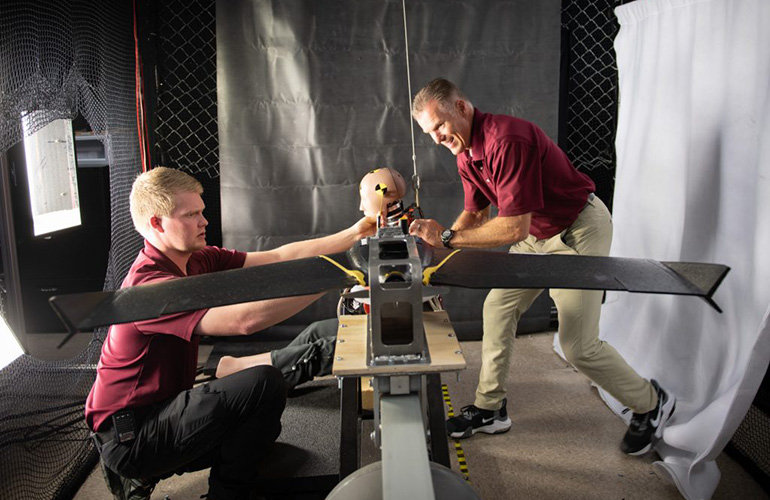|
Listen to this article
|

(From left to right) Engineer Jeremy Spink and injury biomechanics expert Barry Miller set up an impact test for a drone. | Source: Virginia Tech
Three of AgEagle’s eBee X series drones are the first to pass Virginia Tech’s set of test methods that demonstrate adherence to the Federal Aviation Administration’s (FAA) requirements for drone flights over people.
This approval means anyone operating one of the approved AgEagles eBee X drones, the eBee X, eBee GEO and eBee TAC, in an applicable configuration can legally fly it over people. This process removes the need for users to seek permission for each individual operation through a waiver system.
AgEagle’s eBee X fixed-wing drones are typically used for mapping, surveying and inspections. The lightweight, foam aircraft weigh less than 4.4 lbs.
“We are confident that this will serve as a key driver in the growth of eBee utilization in the United States,” Barrett Mooney, AgEagle’s chairman and CEO, said. “It will further improve the business applications made possible by our drone platform for a wide range of commercial enterprises which stand to benefit from the adoption of drones in their businesses — particularly those in industries such as insurance for assessment of storm damage, telecommunications for network coverage mapping and energy for powerline and pipeline inspections, just to name a few.”
The testing methods are a collaboration between the Virginia Tech Mid-Atlantic Aviation Partnership (MAAP), an FAA-designated drone test site, and injury biomechanics experts in the university’s College of Engineering.
In December 2021, the FAA signed off on Virginia Tech’s testing methods for drone flights over people. The new testing methods developed at Virginia Tech were created in response to a change in policy announced by the FAA the year before.
The change laid out a universal standard for flying drones over people, with limitations for flying over large groups. The standard is based entirely on the level of injury the drone could cause, with four risk-based categories the drones could fall into that are based on the amount of kinetic force it would transfer upon impact.
These categories don’t take into account drones that are designed to crack or break on impact, which dissipates the kinetic energy of the drones and reduces the amount of energy transferred to whatever it hit. Virginia Tech’s testing methods are intended to fill that gap to allow more drones to receive widespread approval for flying above people.
“This is a major, major change in how things are done,” Tombo Jones, the test site’s director, said. “The rule provided the first clear understanding of what’s required to safely operate over people. Our means of compliance provided the first pathway for utilizing the rule. This approval demonstrates that that pathway is viable.”
Virginia Tech won a 2022 RBR50 Robotics Innovation Award from our sister publication for its testing methods.






Tell Us What You Think!